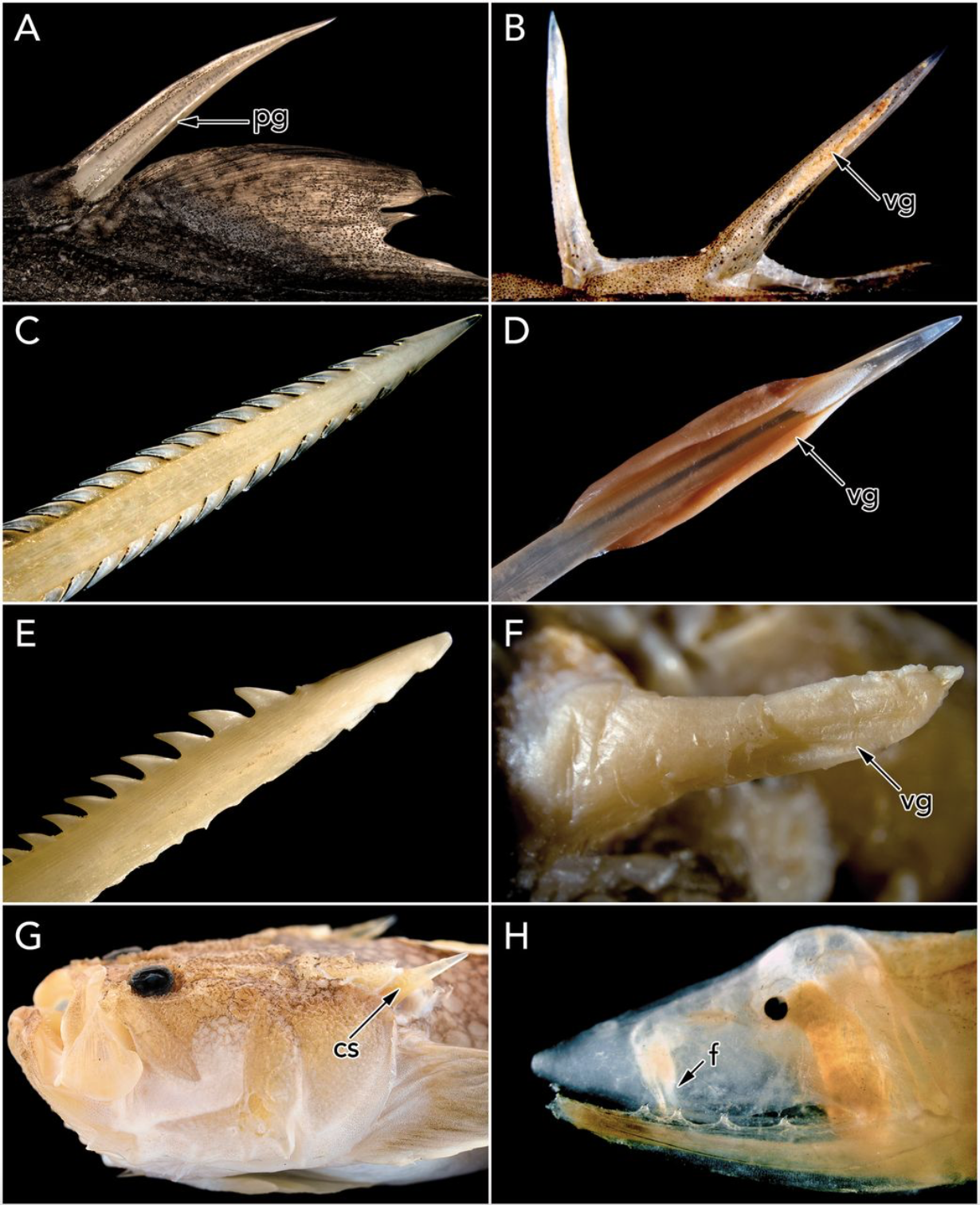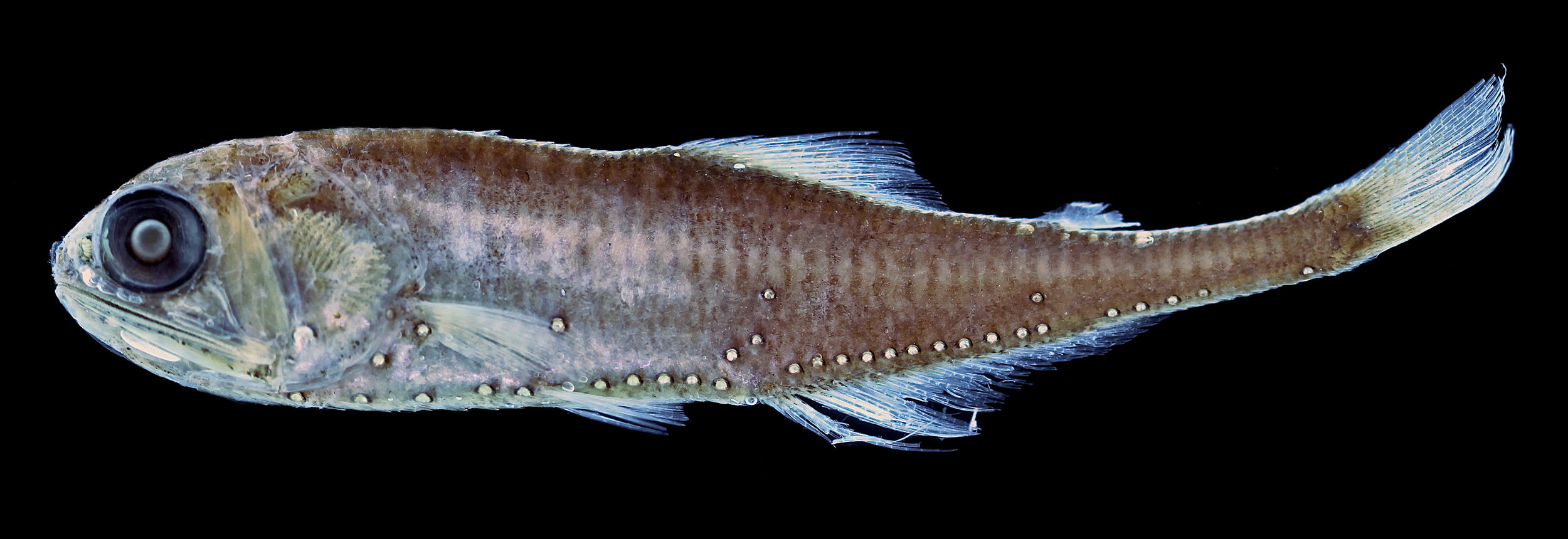Original Source: Martin, R.P., Olson, E.E., Girard, M.G., Smith, W.L., and Davis, M.P. (2018). Light in the Darkness: New Perspective on Lanternfish Relationships and Classification Using Genomic and Morphological Data. Molecular Phylogenetics & Evolution.

Original Source: Martin, R.P., and Davis, M.P. (2016). Patterns of Phenotypic Variation in the Mouth Size of Lanternfishes (Teleostei: Myctophiformes). Copeia. 104(4):795-807.

Original Source: Smith, W.L., Stern, J.H., Girard, M.G., and Davis, M.P. (2016). Evolution of Venomous Cartilaginous and Ray-Finned Fishes. Integrative and Comparative Biology. doi: 10.1093/icb/icw070

Media Coverage:
Blaszczak-Boxe, A. Live Science. "Fish Venom Unveiled: Toxins Evolved Many Times, Study Shows."
Lynch, B. EurekAlert! "Researchers tally huge number of venomous fishes, tout potential for medical therapies."
de Lazaro, E. Sci News. "Study Finds Venom Has Evolved 18 Times in Marine and Freshwater Fishes."
Hays, B. UPI. "Study: Venomous fish could be repository of medicinal compounds."
Original Source: Davis, M.P., Sparks, J.S., and Smith, W.L. (2016). Repeated and Widespread Evolution of Bioluminescence in Marine Fishes. PLOS ONE. 11(6): e0155154.

A preserved Black Dragonfish (Idiacanthus) with bioluminescent barbel.
Media Coverage
Yong, E. National Geographic. "Surprising History of Glowing Fish."
Harvey, C. Mashable. "There are Far More Glowing Fish in the Sea Than Previously Known."
Nuwer, R. Smithsonian Magazine. "Way More Fish Can Make Their Own Light Than We Thought."
Weisberger, M. Live Science. "Flash Mob! Glowing in Fishes More Widespread Than Thought." Image Gallery
Feltman, R. The Washington Post. "Glow-in-the-Dark Fish Have Evolved Over and Over Again."
Kuhr, M. Newsweek. "Bioluminescence is Spreading to New Fish Species."
Lewis, T. The Scientist. "Evolution of Fish Bioluminescence."
Sierra, C. Pulse Headlines. "Glowing deep ocean fishes have evolved at least 27 times."
Navarro, A. Tech Times. "Glow-in-the-dark Ocean Fish Are More Widespread Than Known."
PLOS. EurekAlert! "New research shines light on evolutionary variety of bioluminescent ocean fishes."
AMNH. News and Blogs. "Bioluminescence Evolved Frequently in Fish."
Original Source: Gruber, D.F., Loew, E.R., Deheyn, D.D., Akkaynak, D., Gaffney, J.P., Smith, W.L., Davis, M.P., Stern, J.H., Pieribone, V.A., and Sparks, J.S. (2016). Biofluorescence in Catsharks (Scyliorhinidae): Fundamental Description and Relevance for Elasmobranch Visual Ecology. Scientific Reports. 6, 24751; doi: 10.1038/srep24751
Media Coverage
Howard, B.C. National Geographic. "Through a Shark's Eyes: See How They Glow in the Deep."
Preston, E. The Atlantic. "Scientists Have Developed Shark Vision."
Ossola, A. Popular Science. "Sharks Glow, But Only For Each Other."
Snyder, K. EurekAlert!. "Patterns of Glowing Sharks Get Clearer with Depth."
Feltman, R. The Washington Post. "Scientists Built a Special Camera to Study Glow-In-The-Dark Sharks."
Rene Martin (Masters Student, St. Cloud State University) was recently awarded a Edward C. Raney Grant ($800) from the American Society of Ichthyologists and Herpetologists to support her work on the evolution of deep-sea fishes.

Our new lab paper on the evolution of pearleye fishes (Aulopiformes: Scopelarchidae) was recently published in the journal Copeia. This study investigates the evolutionary relationships among pearleye species with molecular (eight genes) and morphological data. A new genus of pearleye is diagnosed, Lagiacrusichthys, from a previously described species (Benthalbella macropinna) distributed in Antarctic waters.
A specimen of Lagiacrusichthys under fluorescent lighting and modified to a blue hue.
The newly recognized antarctic genus Lagiacrusichthys is named for a wyvern, a dragon-like creature, specifically the sea-wyvern Lagiacrus (made famous by Monster Hunter), known for his fierceness and for inhabiting the deep. As both are rather ferocious coldwater predators, I named Lagiacrusichthys after the fictional monster Lagiacrus. In a remarkable coincidence, the paper diagnosing Lagiacrusichthys was released during the same week as the newest entry in the Monster Hunter series, Monster Hunter 4 Ultimate.

The sea-wyvern Lagiacrus from the Monster Hunter series of games.
Pearleyes are known for their dorsally directed tubular and semi-tubular eyes, which allow them to hunt prey above them in the water column. Pearleye fishes possess an array of visual specializations associated with living in the deep sea, including that their tubular eyes are highly capable of observing bioluminescent light, with the ability to pinpoint bioluminescent emissions from a distance of at least six meters.
Original Source: Davis, M.P. (2015). Evolutionary Relationships of the Deep-Sea Pearleyes (Aulopiformes: Scopelarchidae) and a New Genus of Pearleye from Antarctic Waters. Copeia. 103(1):64-71.
Funding for this work was provided by the National Science Foundation (DEB 1258141 and 106086) and the American Museum of Natural History Lerner-Grey Marine Research Grant.

Article "Lover's Lure?" by Ashley Braun, featured in Natural History Magazine
The findings from our open-access publication regarding speciation and bioluminescence in deep-sea fishes were recently highlighted in print within the pages of Natural History Magazine (5/14 Issue). This study was also covered by online outlets, including The Scientist, e! Science News, and Nature World News.
Original Source: Davis, M.P., Holcroft, N.I., Wiley, E.O., Sparks, J.S., and Smith, W.L. (2014). Species-Specific Bioluminescence Facilitates Speciation in the Deep Sea. Marine Biology. DOI: 10.1007/s00227-014-2406-x.
Funding for this work was provided by the National Science Foundation (DEB 1258141 and 1257555).

Viperfish (Chauliodus). Image by Leo Smith.
Our open-access paper investigating the evolution of species-specific bioluminescent structures in the deep-sea lineages of lanternfishes (Myctophiformes) and dragonfishes (Stomiiformes) was recently published in the journal Marine Biology. We show, for the first time, that deep-sea fishes that possess species-specific bioluminescent structures (e.g., lanternfishes, dragonfishes) that may be used for communication are diversifying into new species at a more rapid rate than deep-sea fishes that utilize bioluminescence in ways that would not promote isolation of populations (e.g., camouflage, predation). This work adds to our understanding of how life thrives and evolution shaped present-day biodiversity in the deep sea, the largest and arguably least explored habitat on earth.
Davis, M.P., Holcroft, N.I., Wiley, E.O., Sparks, J.S., and Smith, W.L. (2014). Species-Specific Bioluminescence Facilitates Speciation in the Deep Sea. Marine Biology. DOI: 10.1007/s00227-014-2406-x.

Blue Lanternfish (Tarletonbeania crenularis). Image by Matthew P. Davis.
Our recent publication regarding the evolution of biofluorescence across the fishes tree of life is now published and available through open access in the journal PLoS ONE.
Sparks, J.S., Schelly, R.C., Smith, W.L., Davis, M.P., Tchernov, D., Pieribone, V., and Gruber, D.F. (2014). The Covert World of Fish Biofluorescence: A Phylogentically Widespread and Phenotypically Variable Phenomenon. PLoS ONE. 9(1): e83259.
A team of researchers led by scientists from the American Museum of Natural History has released the first report of widespread biofluorescence in the tree of life of fishes, identifying more than 180 species that glow in a wide range of colors and patterns.
When I was employed as a postdoctoral research scientist at The Field Museum, I was able to start a podcast with colleagues (Beth Sanzenbacher, Eric Ahlgren, and Leo Smith) that dived into various topics surrounding the biodiversity of fishes. These podcasts included discussions on the general biology, ecology, and evolution of fishes. We produced 26 episodes at The Field Museum with associated blog posts before relocating to work at the University of Kansas. You can check out all 26 episodes of our podcast on iTunes and at The Field Museum's website.